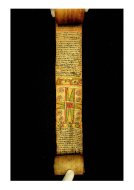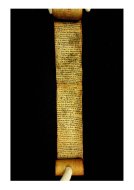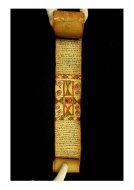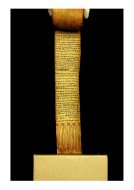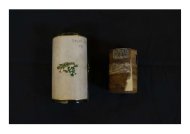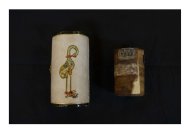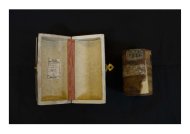|
Shelfmark |
Fondo Orientale, Crypt Aet. 12
|
|
Owning institution |
Biblioteca statale del Monumento nazionale di Grottaferrata |
|
Typology |
Scroll |
|
Copying date |
1779–1800, dated on a prosopographical basis. |
|
Title |
Protective prayers against diseases |
|
Subject |
Prayers, Healing |
|
Language |
Gǝʿǝz |
|
Short description of the content |
1) Ṣälot bäʾǝntä Barya wä-mäftǝḥe śǝray (“Prayer against the Barya and for undoing charms”), containing numerous place names associated with spells. Incipit: በስመ፡ … ጸሎት፡ በእንተ፡ ባርያ፡ ወመፍትሔ፡ ሥራይ፡ ማዲን፡ አፍሮሄም፡ በስመ፡ ዮድ፡ በስመ፡ መግዝር፡ ይወአር፡ ወበስመ፡ ፋዲ፡ ይዘርዘር፡ በገብሮ፡ ሰብእ፡ 2) Ṣälot bäʾǝntä mäftǝḥe śǝray (“Prayer for undoing the charms”) Incipit: ጸሎት፡ በእንተ፡ ምፍትሔ፡ ሥራይ፡ ንዌጥን፡ በረድኤተ፡ እግዚአብሔር፡ ልዑል፡ ወክቡር፡ መጽሐፈ፡ ፍትሐተ፡ ሥራይ፡ ሥራየ፡ ዐረቢ፡ ወግብፃዊ፡ ሥራየ፡ ኬልቄዶን፡ ወአይሁዳዊ፡ 3) Ṣälot bäʾǝntä ḥǝmamä ʿäynät (“Prayer against the suffering [caused] by the [evil] eye”) Incipit: ጸሎት፡ በእንተ፡ ሕማመ፡ ዓይነት፡ መፍትሔ፡ ሥራይ፡ ወቍርጥሚት፡ ታሽራን፡ ቍሮሬፎን፡ ፀባኦት፡ አውናሽ፡ ከዋክ፡ ከዋክ፡ አኮ፡ 4) Ṣälot bäʾǝntä ḥǝmamä Barya wä-Legewon (“Prayer against the suffering [caused] by the Barya and the Legewon”) Incipit: ጸሎት፡ በእንተ፡ ሕማመ፡ ባርያ፡ ወሌጌዎን፡ ርኩስ፡ ወሰጋአነ፡ ቀትር፡ ለቡዳ፡ ለጽላዋጊ፡ ፍጌን፡ ወፈለ[…]፡ ዘር፡ ወትግሪዳ፡ ዳፍን፡ 5) Ṣälot bäʾǝntä ḥǝmamä qwǝrṣät (“Prayer against colic”). The entire text is the following: በስመ፡ … ጸሎት፡ በእንተ፡ ሕማመ፡ ቍርፀት፡ በከጥኮስ፡ ስምከ፡ በዳፌል፡ ስምከ፡ በኄርያኖስ፡ ስምከ፡ በፍልፍያኖስ፡ ስምከ፡ ተማኅፀንኩ፡ ከመ፡ ታድኅፀኖ፡ እምሕማመ፡ ቍርፀት፡ ለገብርከ፡ ተክለ፡ ሚካኤል፡ 6) Ṣälot bäʾǝntä ḥǝmamä käbd (“Prayer against the stomachache”). Incipit: ጸሎት፡ በእንተ፡ ሕማመ፡ ከብድ፡ እንዘ፡ ይበጽብጽ፡ ከርሠ፡ ወይጔጸጉጽ፡ ገበዋተ፡ ወያደቅቅ፡ አእፅምተ፡ ወያጠዊ፡ አንጀተ፡ ወአማዑተ፡ ጀር፡ ጀር፡ ጀር፡ ለከውሸር፡ |
|
Writing material |
Parchment of unspecified animal type |
|
Outer size |
1810 x 74 mm (407 + 673 + 694) |
|
Number of strips |
3 |
|
Sewing |
The strips are joined together by means of small parchment strips. |
|
Leather case |
The scroll is stored inside a painted wooden case. |
|
Layout |
1 column |
|
Ruling |
– |
|
Ruling pattern |
– |
|
Scribe |
Unknown |
|
Colophon |
– |
|
Additional notes |
– |
|
Decoration |
On the first strip, at the top of text 1: nine squares between two geometric bands; the squares contain a human face inscribed in an eight-pointed star. Colours: red, yellow, green. On the second strip: an eight-pointed star between two decorative bands (the upper band contains eyes); a human face is inscribed inside the star. Colours: red, yellow, green. On the second strip: an angel between two decorative bands. Colours: red, yellow, green. On the third strip: nine squares between two geometric bands; the squares contain a human face inscribed in an eight-pointed star. Colours: red, yellow, green. On the third strip, at the end of the last text: vertical zig-zag lines between two geometric bands, in red and yellow. |
|
State of preservation |
Discrete. |
|
Provenance and history |
Unknown provenance. The scroll mentions Nǝgus Täklä Giyorgis, who ruled discontinuously for six distinct periods from 1779 to 1800, and ṗaṗṗas Abba Yosab, in tenure from 1770 to 1803. This indicates that the scroll was produced between 1779 and 1800. The individuals mentioned in the supplication formulas (Ḍämrä Qal, Wäldä Yoḥannǝs, Wäldä Gärima, and Täsfa Mikaʾel), all of them indicated as ‘your servant’ (ገብርከ፡), might be those of later owners, since their names are written over names previously erased. It is not known when the manuscript entered the abbey library, presumably before 1908, year of death of Father Rocchi. The scroll is mentioned in Zanutto S., 1932, Bibliografia etiopica, in continuazione alla «Bibliografia etiopica» di G. Fumagalli, II: Manoscritti etiopici, p. 80 (nr. 153). |



